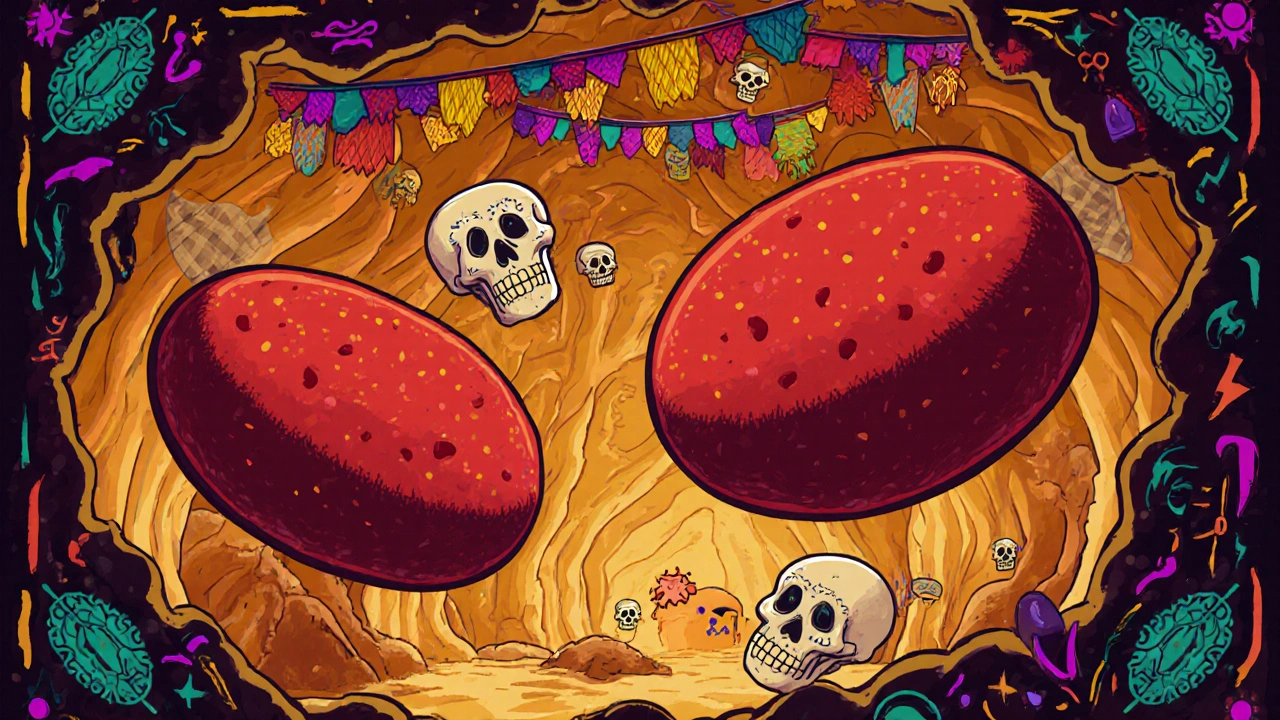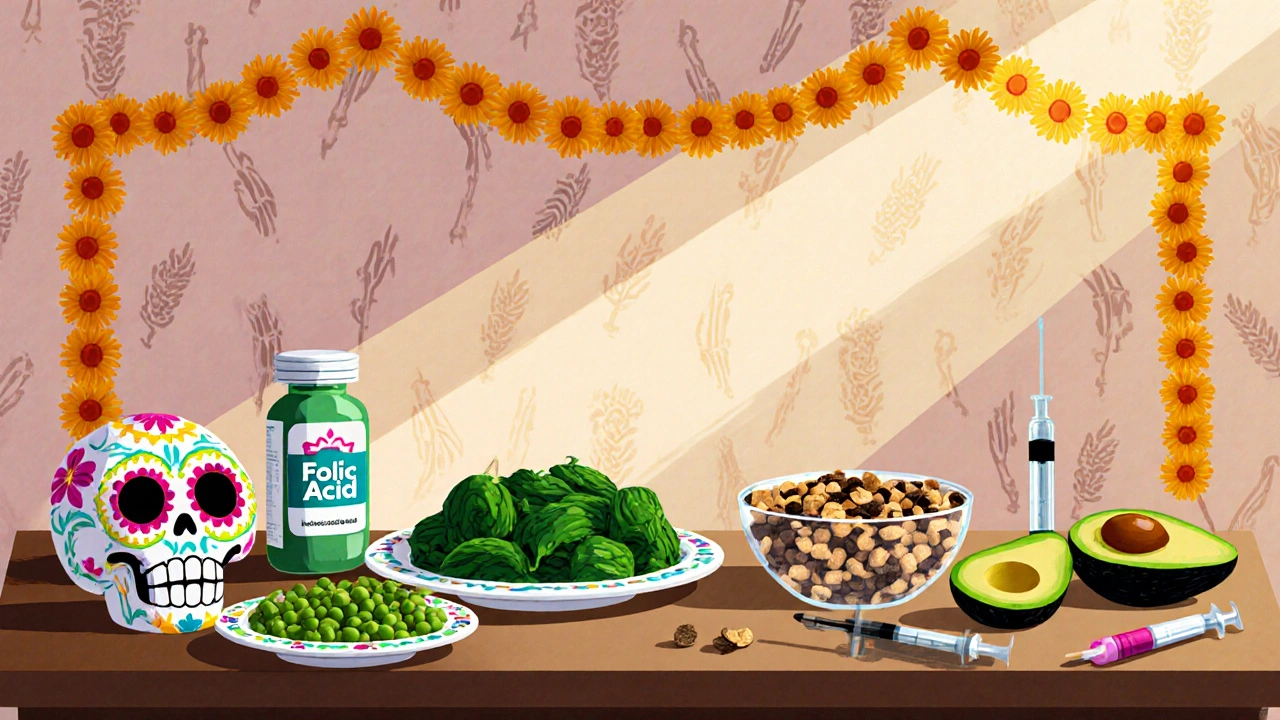How Folic Acid Deficiency Triggers Megaloblastic Anemia in IBD Patients
 Oct, 19 2025
Oct, 19 2025
Folate Intake Calculator for IBD Patients
This tool helps you estimate your daily folate intake from food sources. For IBD patients, the recommended daily intake is 400-800 mcg to compensate for malabsorption. If you're on folate-antagonist medications like sulfasalazine or methotrexate, you may need higher doses.
Folate-Rich Food Sources
Enter the amounts you consume daily from these folate-rich foods:
Your Daily Folate Intake
0 mcg
Recommended intake for IBD patients: 400-800 mcg daily
When you hear the phrase “anemia” you might picture fatigue, shortness of breath, or pale skin. For people living with inflammatory bowel disease (IBD), the story often has an extra twist: a lack of folic acid can turn a regular iron‑deficiency anemia into a full‑blown megaloblastic anemia. Below we untangle why that happens, what to look for, and how to fix it before it knocks you down.
What is Folic Acid Deficiency is a shortage of the B‑vitamin folate that impairs DNA synthesis and red‑cell formation?
Folate, also called vitamin B9, is essential for making new cells. Your gut absorbs it mainly in the duodenum and upper jejunum, and your liver stores a modest reserve. If you don’t get enough from diet-leafy greens, beans, fortified grains-or if your intestine can’t grab it, levels drop. The result isn’t just tiredness; the bone marrow starts producing oversized, immature red cells, a hallmark of megaloblastic anemia.
How Megaloblastic Anemia develops when DNA synthesis is blocked, leading to large, fragile red blood cells differs from iron‑deficiency anemia
Iron‑deficiency anemia gives you small, pale red cells (low MCV). Megaloblastic anemia flips that: the mean corpuscular volume (MCV) climbs above 100 fL, and the cells look “megaloblastic” under a microscope. The underlying cause is a block in the nucleotide‑building pathway, most often from lacking folate or vitamin B12. Both nutrients are needed to convert homocysteine to methionine-a step that fuels DNA production. Without folate, the marrow can’t keep up, and you end up with those giant, fragile cells that break apart easily.
Why IBD patients are especially vulnerable
Inflammatory bowel disease encompasses two main disorders: Crohn's disease is a chronic inflammation that can affect any part of the gastrointestinal tract, often the small intestine and Ulcerative colitis is a continuous inflammation limited to the colon and rectum. Both conditions can interrupt the normal absorption of nutrients in several ways:
- Malabsorption: Damage to the duodenum (common in Crohn’s) reduces the surface area where folate is picked up.
- Chronic inflammation: Cytokines increase the body’s folate demand and can impair transport proteins.
- Medication side‑effects: Drugs like sulfasalazine, azathioprine, and methotrexate interfere with folate metabolism.
- Dietary restrictions: Patients may avoid fiber‑rich foods that are folate powerhouses, inadvertently cutting their intake.
All these factors create a perfect storm where folate levels dip, and the bone marrow’s red‑cell factory stalls.

Common culprits that drain folate in IBD
Even if your gut looks healthy, certain meds can silently chew up folate:
- Sulfasalazine an anti‑inflammatory drug that competes with folate for absorption.
- Methotrexate, a low‑dose chemotherapy agent used for remission, directly blocks dihydrofolate reductase.
- Trimethoprim‑sulfamethoxazole (used for infections) can also act as a folate antagonist.
If you’re on any of these, your doctor may already be tracking your blood counts, but it’s worth asking about a folate check specifically.
How doctors diagnose folate‑related megaloblastic anemia
Blood work is the first clue. Look for these patterns:
| Parameter | Folate Deficiency | Vitamin B12 Deficiency |
|---|---|---|
| MCV | ↑ (>100 fL) | ↑ (>100 fL) |
| Serum Folate | Low | Normal |
| Serum B12 | Normal | Low |
| Homocysteine | ↑ | ↑ |
| Methylmalonic Acid | Normal | ↑ |
Beyond the numbers, a peripheral blood smear will show macro‑ovalocytes and hypersegmented neutrophils-a visual hallmark of megaloblastic changes.
To pinpoint why you’re low, doctors may order a folate absorption test or check for intestinal inflammation with endoscopy. In many cases, the pattern of malabsorption aligns with active Crohn’s lesions in the upper small bowel.
Fixing the deficiency: diet, supplements, and medication tweaks
First, talk to your gastroenterologist about adjusting any folate‑antagonist drugs. If you’re on sulfasalazine, a simple switch to mesalamine (which doesn’t block folate) can make a big difference.
Second, supplement wisely. Oral folic acid at 1 mg daily is usually enough for mild deficiency, but severe cases may need 5 mg three times a week, especially if you’re still on methotrexate. Intramuscular folate shots are an option when gut malabsorption is profound-they bypass the intestine entirely.
Third, boost dietary intake. Aim for at least two servings of folate‑rich foods each day:
- Spinach or kale (½ cup cooked) - 90 µg
- Black‑eye peas (½ cup) - 100 µg
- Fortified breakfast cereal (1 cup) - 140 µg
- Avocado (½ fruit) - 60 µg
People with IBD often have limited appetite, so fortifying smoothies or soups can help hit the numbers without a big meal.

Monitoring and when to seek help
After starting folate, repeat CBC and serum folate in 4-6 weeks. If hemoglobin climbs and MCV drops toward normal, you’re on the right track. Persistent anemia despite supplementation signals an additional problem-maybe concurrent B12 deficiency, ongoing bleeding, or a flare that’s still damaging the gut.
Red‑flag symptoms that demand urgent care include sudden worsening of fatigue, chest pain, or shortness of breath at rest. Those could indicate severe anemia or a cardiovascular strain.
Quick checklist for patients and clinicians
- Identify IBD type (Crohn’s vs. ulcerative colitis) and disease location.
- Review medication list for folate antagonists.
- Order CBC, serum folate, B12, homocysteine, and methylmalonic acid.
- Start oral folic acid 1 mg daily; increase to 5 mg if malabsorption is severe.
- Incorporate folate‑rich foods or fortified products.
- Recheck labs in 4-6 weeks; adjust dose or switch meds as needed.
- Watch for neurological signs (tingling, gait problems) that suggest B12 involvement.
Frequently Asked Questions
Can I get enough folate from diet alone?
For most people, a balanced diet with leafy greens, beans, and fortified grains meets the daily 400 µg requirement. IBD patients, however, often have reduced absorption, so dietary sources may need to be boosted with supplements.
Is folic acid deficiency the same as vitamin B9 deficiency?
Yes. "Folic acid" is the synthetic form found in supplements and fortified foods, while "vitamin B9" refers to the natural folate found in foods. Both serve the same biological function.
Why do my doctors check homocysteine levels?
Elevated homocysteine can result from low folate or B12. It helps distinguish which vitamin is lacking and also flags cardiovascular risk.
Can I stay on methotrexate if I’m folate‑deficient?
Often, doctors prescribe folic acid supplements alongside methotrexate to offset the drug’s folate‑blocking effect. The dose is usually 1 mg daily, but follow your physician’s guidance.
What symptoms signal megaloblastic anemia beyond fatigue?
Look for shortness of breath on mild exertion, pale skin, dizziness, and sometimes a smooth, sore tongue. In severe B12‑related cases, nerve tingling or balance issues may appear.
Bottom line: if you have IBD and notice any of the classic anemia signs, ask your doctor to check folate. Catching a deficiency early stops the cascade toward megaloblastic anemia and keeps you feeling stronger for the daily challenges of managing IBD.
DHARMENDER BHATHAVAR
October 19, 2025 AT 15:02Regular monitoring of serum folate and CBC indices is essential for IBD patients, as early detection can prevent the progression to megaloblastic anemia.
Kevin Sheehan
October 31, 2025 AT 03:49It is absurd that clinicians still overlook the biochemical cascade linking folate deficiency to macrocytic red cells; the human body is a finely tuned system, and when you sabotage one nutrient pathway you inevitably destabilize the whole hematopoietic network.
Jay Kay
November 11, 2025 AT 17:35Foliate deficiency not only enlarges red cells but also impairs DNA replication, leading to the classic hypersegmented neutrophils on smear.
Penny Reeves
November 23, 2025 AT 07:22Folate, chemically known as pteroylglutamic acid, serves as a one‑carbon donor in the synthesis of thymidine and purines, which are indispensable for DNA replication in rapidly dividing bone‑marrow precursors. When intestinal absorption is compromised-as is frequently the case in Crohn’s disease affecting the duodenum-the systemic pool of this vitamin dwindles, precipitating a bottleneck in the deoxyribonucleotide synthesis pathway. The resultant stalling of the S‑phase forces erythroid progenitors to undergo abortive mitosis, producing macro‑ovalocytes that are structurally fragile and prone to premature hemolysis. Clinically, this manifests as the elevated mean corpuscular volume and the characteristic hypersegmented neutrophils observed on peripheral smear. Moreover, the homocysteine remethylation cycle is intimately tied to folate availability; elevated homocysteine not only signals a folate shortfall but also portends an increased risk of thromboembolic events, a concern particularly salient in the pro‑inflammatory milieu of IBD. It is noteworthy that methotrexate, a cornerstone immunosuppressant, exerts its therapeutic effect precisely by inhibiting dihydrofolate reductase, thereby exacerbating the folate deficit unless counterbalanced with supplemental folic acid. The therapeutic window for folic acid supplementation is surprisingly wide: low‑dose oral regimens (1 mg daily) suffice for mild deficiencies, while severe malabsorption may warrant high‑dose oral (5 mg three times weekly) or intramuscular administrations. Dietary strategies should not be dismissed either; a single cup of fortified cereal can furnish roughly 140 µg of folate, complementing the contributions from leafy greens and legumes. In practice, serial monitoring-baseline CBC, serum folate, homocysteine, and, when indicated, methylmalonic acid-allows clinicians to titrate supplementation and detect concurrent vitamin B12 deficits, which share overlapping hematologic signatures but demand distinct therapeutic approaches. Finally, patient education is paramount; individuals with IBD often self‑impose dietary restrictions that inadvertently curtail folate intake, so counseling on fortified foods and appropriate supplement usage can bridge this nutritional gap and avert the cascade toward megaloblastic anemia.
Sunil Yathakula
December 4, 2025 AT 21:09Hey, i totally get how frustrating it can be when your gut just won’t soak up the good stuff – adding a daily folate pill and a smoothie with spinach can really turn the tide.
dennis turcios
December 16, 2025 AT 10:55While the biochemical cascade is indeed compelling, clinical data suggest that routine folate supplementation alone does not uniformly reverse macrocytosis unless the underlying inflammatory burden is concurrently addressed.